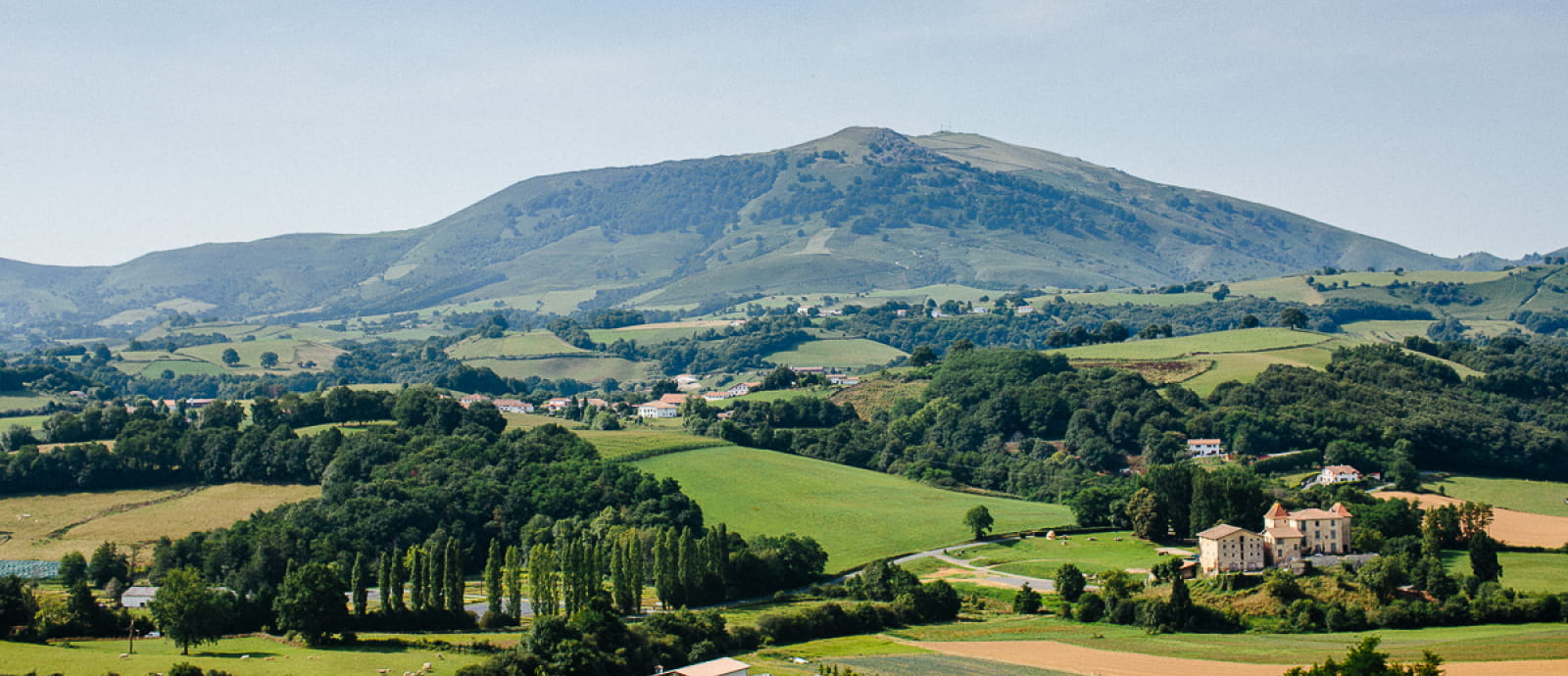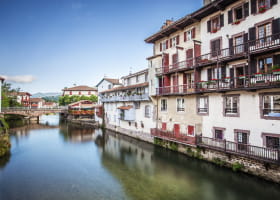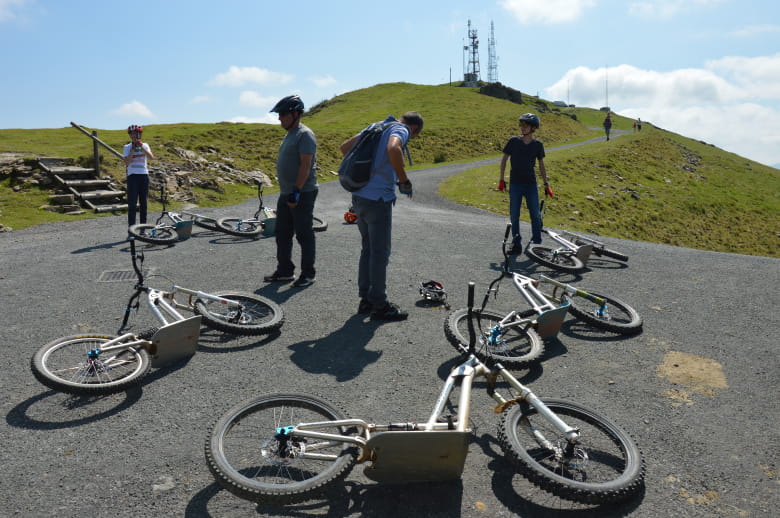
Around the Baigura
Autour du Baigura
The villages at the foot of the Baigura
Mendionde and Macaye
Activity in the village of Macaye is marked by pastoral activities. For 30 years, the cheese factory Onetik, meaning “that comes from good things” in Basque, has been collecting sheep and cow's milk from numerous local farms to transform it into cheese. More recently, goat's milk has been added to complete the delicious choice offered in the shop on the road to Mendionde.
Like the village of Macaye, Mendionde is a town that is truly a balcony overlooking the mountains of the Basque Country, from Mt. Mondarrain to the peak of Orhi. Garro castle attracts passers-by: privately owned since the 13th century, it was bequeathed to the city of Bayonne, then to the village of Mendionde in the 20th century. The site is now a pole of organic agriculture; it hosted the Euskal Herria Zuzenean music festival a few years ago
Hélette
The church in the village of Hélette has wooden galleries dating from 1695. There is a statue of St. James the Great with all the pilgrim's paraphernalia: a flask, staff and calabash. The contemporary Santiago de Compostela pilgrims who sleep in communal lodgings follow the path along the River Nive (not marked out) from Bayonne to Saint-Jean Pied de Port.
Baigura, an imposing mountain
In the north of the Basque Country, from the River Adour, you can see Mt. Baigura from afar because it is isolated between the province of Labourd and the province of Basse Navarre. At 897 metres high, its regular shape seen from the north is rather reminiscent of the harmonious Mount Fuji Yama. To the south, the slopes are steep and abrupt; walking up from Ossès is far from being just a short walk. Baigura has always been at the crossroads of different economic activities: agriculture and pastoralism, forestry and work in kaolin quarries until the 1970s, and more recently, sports and hiking with the creation of the Baigura outdoor sports leisure centre in Mendionde, between Hélette and Louhossoa.
A little train to always go higher
A road enables you to go to the top of Mt. Baigura but it is reserved for pastoral activity in order to preserve the site. Mt. Baigura has long been popular with paragliders who find optimal flight conditions and easy access there. Watching how vultures fly helps them to spot updrafts, guaranteeing a long flight. The little train, which operates almost all year round with a variable schedule depending on the season, offers a breath-taking panorama of the Basque hills, the Pyrenees and the Adour valley to the north. If you are walking with children, you can ask for a stop halfway to enjoy the nature trail.
An outdoor sports centre
The creation of Baigura outdoor sports centre by the towns of Mendionde, Macaye and Hélette has led mountain professionals to offer many activities. A must-do: treat yourself to your first accompanied paragliding flight and fly like a bird! But there are also other ways to discover this mountain: by climbing the rock faces near the summit, by mountain biking, by descending it on a mountain scooter with the reassuring supervision of mountain sports professionals… It is also a great place for hiking; ask for the different trails at the front desk. After your efforts and excitement, treat yourself to some refreshments at the leisure centre’s bar and restaurant....
A paradise for sheep and pottoks (an ancient breed of pony native to the Basque Country)
Pastoral activity is predominant on the mountain and farmers send part of their flock of sheep (the sturdiest) up Mt. Baigura commencing the month of June. This allows them to build up their winter food supply without drawing on reserves. There are about thirty bordes (basic shepherd’s huts comprising a shelter and a stone wall). Pottoks, small rustic horses that live there all year round, coexist with the sheep. They are characterized by their short legs and large belly because they need to constantly swallow large quantities of grass to feed themselves. You must always make sure to keep your distance because, although they are very cute, they may have unpredictable reactions.
In July and August, meet up with a shepherd
The mountain is not just a recreational area for walking and hiking, it is maintained thanks to pastoral activity. On Friday mornings in July and August, at 9:30 am, come to the Baigura leisure centre to meet a shepherd, understand his profession, herd management, the dog's work and his daily life in the mountains. You will go up to the top with him in the little train to get a good view and have a drink ... We recommend taking a picnic to enjoy the site and then come back down in the afternoon.
Not to be missed
Highlights
Makea Oinez in Macaye
Macaye's hiking day, Makea Oinez (“Macaye on foot” in Basque), created in 2000 by and for the villagers, is a pioneering event that has grown from 80 hikers to more than 900! This great hiking occasion offers three circuits for all levels: Mt. Ursuia, Mt. Baigura and Makea Oinez. The latter is the ultimate for seasoned walkers capable of taking on 38 km with climbs totalling 1,930-metres! Since last year, a trail has been opened up for all-terrain, Joëlette chairs, making the day’s hiking excursion accessible to everyone. Next meeting in 2021 is scheduled for the 2nd Sunday in October.
Hélette pottok fair (an ancient breed of pony native to the Basque Country)
St. Catherine’s Day is a serious matter for Hélette as it is the day of the pottok fair. For the past 300 years, on 25 November, the village has organized one of the largest fairs in the Basque Country for buying and selling pottok ponies, an ancient breed native to the Basque Country formerly used for work in the fields. The range of animals in the fairground has diversified; you can now find different breeds of horses and ponies as well as donkeys.
Corpus Christi
Corpus Christi, called Besta Berri in Basque literally meaning “New Festival”, is celebrated on the 2nd and 3rd Sunday following Pentecost. Besta Berri is the only religious celebration that allows dancing inside the church: the Zapurrak (sappers) and soldiers in Napoleonic costumes enter and perform precise dance steps. After mass in the morning or Vespers in the afternoon, the procession of the Blessed Sacrament takes place in the village square and makilari (ceremonial baton twirlers) complete the procession.



































